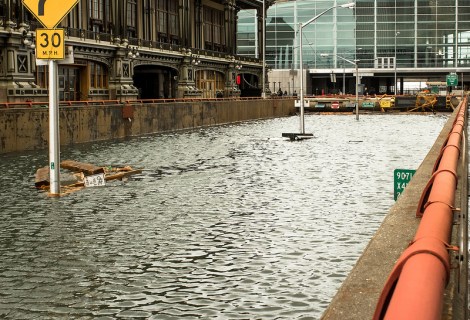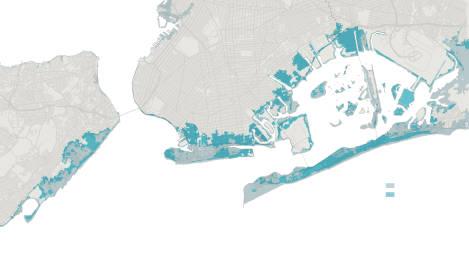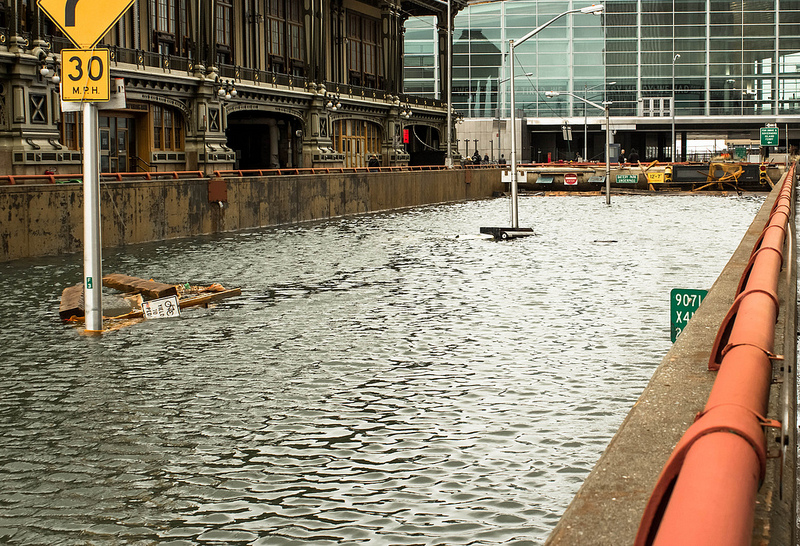
The flooded Brooklyn-Battery Tunnel.
Midnight tonight marks the three-month anniversary of Hurricane Sandy making landfall in New Jersey. To celebrate, Congress finally cleared the aid package for victims of the storm. You’ll forgive the East Coast if it doesn’t send a thank-you note.
From The New York Times:
By a 62-to-36 vote, the Senate approved the measure, with 9 Republicans joining 53 Democrats to support it. The House recently passed the bill, 241 to 180, after initially refusing to act on it amid objections from fiscal conservatives over its size and its impact on the federal deficit.
The newly adopted aid package comes on top of nearly $10 billion that Congress approved this month to support the recovery efforts in New York, New Jersey, Connecticut and other states that were battered by the hurricane in late October.
The money will provide aid to people whose homes were damaged or destroyed, as well as to business owners who had heavy losses. It will also pay for replenishing shorelines, repairing subway and commuter rail systems, fixing bridges and tunnels, and reimbursing local governments for emergency spending.
Obama pledged to sign the bill as soon as it gets to him.
Yesterday, the Federal Emergency Management Agency presented its own gift to the community: new flood maps for the New York City area. The reassessment of risk to neighborhoods updates the existing, 30-year-old maps, adding some 35,000 new homes and businesses to at-risk areas.

New York TimesRevamped flood zones. Click to embiggen.
In a separate story, the Times reports:
The maps will not formally go into effect for about two years, but the mayor’s office was already preparing an executive order to help owners of damaged homes rebuild to higher standards. That means that a badly damaged home that was not in the old flood zone, but is in the new one, would be allowed to rebuild to prepare for dangers predicted in the new maps. For instance, a home could be hoisted onto posts or pilings, which might have previously been disallowed because of zoning. …
To help offset the costs, [Michael] Byrne, of FEMA, said homeowners with federally backed insurance policies could get up to an additional $30,000 for rebuilding their homes to comply with new codes. Mr. Holloway said it was hoped that federal aid in the wake of the storm would include money to help homeowners better protect their homes.
According to the agency, owners of a $250,000 home with a ground floor built four feet below sea level could pay up to $9,500 a year for flood insurance, compared with $427 for homes built three feet above the flood line.
You may remember that the first, $10 billion package approved by Congress went to bolster FEMA’s ability to pay out claims. For years, the agency has been charging flood-insurance premiums that don’t reflect the actual risk of flooding across the country, meaning that it has been operating at a loss. Homeowners in areas that have been added to the newly mapped flood zones will have to pay higher insurance rates, but not for another few years. Which means FEMA will continue to bring in less money than it needs and will be constrained in paying out claims.
Worse still, FEMA’s new maps reflect only the present conditions: current sea levels, current storm estimates.
Mr. Byrne said the maps were based on current conditions. “We’re not taking into consideration any future climate change,” he said.
Within a decade, then, even FEMA’s new maps will be out-of-date. Sea-level rise is happening faster than anticipated, and New York Harbor is witnessing that directly. If FEMA waits another 30 years to update the maps, the harbor could be almost four inches higher than it is today.
The constraint is financial. Elements of the government are loathe to spend on preventative measures and are reluctant to provide additional funding to programs like FEMA. It took them three months to OK even minimal aid to the largest city in the country. How many years will it be before Congress approves resources to combat climate change preemptively?




